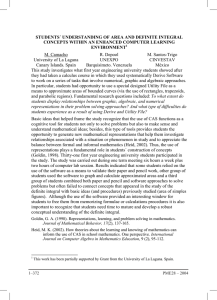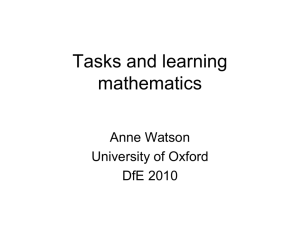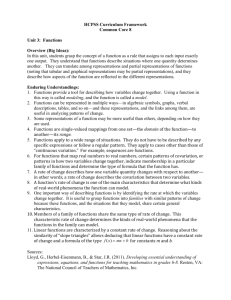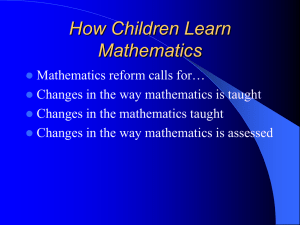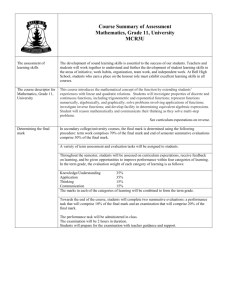AN INVESTIGATION OF A PRESERVICE TEACHER’S USE OF INVOLVING EXPONENTIAL RELATIONSHIPS
advertisement
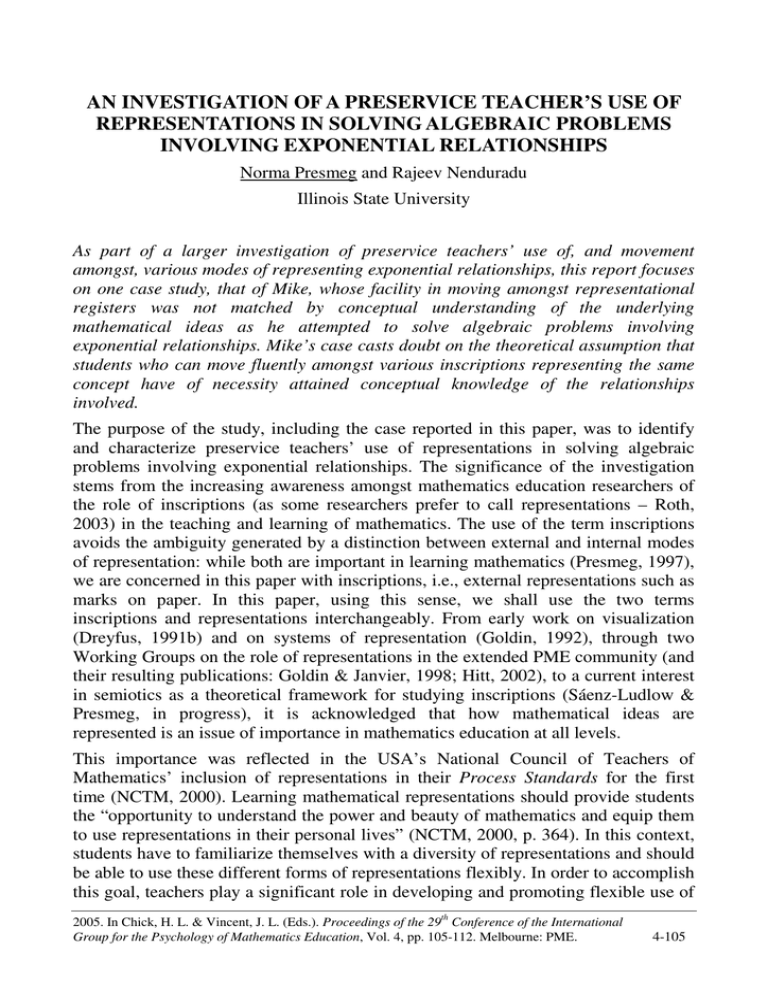
AN INVESTIGATION OF A PRESERVICE TEACHER’S USE OF REPRESENTATIONS IN SOLVING ALGEBRAIC PROBLEMS INVOLVING EXPONENTIAL RELATIONSHIPS Norma Presmeg and Rajeev Nenduradu Illinois State University As part of a larger investigation of preservice teachers’ use of, and movement amongst, various modes of representing exponential relationships, this report focuses on one case study, that of Mike, whose facility in moving amongst representational registers was not matched by conceptual understanding of the underlying mathematical ideas as he attempted to solve algebraic problems involving exponential relationships. Mike’s case casts doubt on the theoretical assumption that students who can move fluently amongst various inscriptions representing the same concept have of necessity attained conceptual knowledge of the relationships involved. The purpose of the study, including the case reported in this paper, was to identify and characterize preservice teachers’ use of representations in solving algebraic problems involving exponential relationships. The significance of the investigation stems from the increasing awareness amongst mathematics education researchers of the role of inscriptions (as some researchers prefer to call representations – Roth, 2003) in the teaching and learning of mathematics. The use of the term inscriptions avoids the ambiguity generated by a distinction between external and internal modes of representation: while both are important in learning mathematics (Presmeg, 1997), we are concerned in this paper with inscriptions, i.e., external representations such as marks on paper. In this paper, using this sense, we shall use the two terms inscriptions and representations interchangeably. From early work on visualization (Dreyfus, 1991b) and on systems of representation (Goldin, 1992), through two Working Groups on the role of representations in the extended PME community (and their resulting publications: Goldin & Janvier, 1998; Hitt, 2002), to a current interest in semiotics as a theoretical framework for studying inscriptions (Sáenz-Ludlow & Presmeg, in progress), it is acknowledged that how mathematical ideas are represented is an issue of importance in mathematics education at all levels. This importance was reflected in the USA’s National Council of Teachers of Mathematics’ inclusion of representations in their Process Standards for the first time (NCTM, 2000). Learning mathematical representations should provide students the “opportunity to understand the power and beauty of mathematics and equip them to use representations in their personal lives” (NCTM, 2000, p. 364). In this context, students have to familiarize themselves with a diversity of representations and should be able to use these different forms of representations flexibly. In order to accomplish this goal, teachers play a significant role in developing and promoting flexible use of 2005. In Chick, H. L. & Vincent, J. L. (Eds.). Proceedings of the 29th Conference of the International Group for the Psychology of Mathematics Education, Vol. 4, pp. 105-112. Melbourne: PME. 4-105 Presmeg & Nenduradu multiple representations during their instruction in mathematics classrooms (National Research Council, 2002). To this end, teacher education programs should include topics in algebra, in particular, those topics that foster preservice teachers’ flexible use of representations (Ball, 1990, 2003). Hence our focus was on the inscriptions used by preservice teachers, as a prelude to further research on ways that this flexible use might be fostered. Exponential functions were chosen because many students and preservice teachers in particular find this a difficult topic to grasp and represent (Goldin & Herscovics, 1991). Thus, the purpose of the research was to identify and characterize different representations that preservice teachers use – and how they use them – in solving algebraic problems involving exponential relationships. THEORETICAL FRAMEWORK The theoretical perspectives that provided lenses were as follows. Firstly, a theory proposed by Dreyfus (1991a) posited that the learning process evolves in four stages through the use of representations, moving from the use of a single representation at the first stage to the ability to make flexible use of representations at the last stage. Moreover, each stage determines individual levels of understanding of a concept. Secondly, our investigation was informed by Duval’s (1999) notion of registers, and his stress on the importance of students being able to work within and among registers, with fluent conversion of representations in this movement. Dreyfus (1991a) argued that abstracting and representing are complementary processes. He then discussed how these two processes are related in learning. In particular, he suggested that the learning process proceeds through four stages: 1) using a single representation, 2) using more than one representation in parallel, 3) making links between parallel representations, and 4) integrating representations and flexible switching between them. For instance, in learning the concept of function, students can start with any one of numerical, graphical, or algebraic representations. In the second stage, these representations may be used in parallel to learn the same mathematical concept. The following stage is reached when students begin to make links among the representations. Abstraction of the mathematical concept is reached in the last stage where students are able to switch flexibly among different representations as well as being able to integrate those representations. Once the fourth stage is attained, students are said to form an abstract notion of the mathematical concept or to “own” that concept. Thus, the four stages can be considered as increasing levels of understanding with an individual having a limited understanding of a concept at stage one and an abstract or highest level of understanding at the fourth stage. Duval (1999) proposed a framework for analysing the cognitive functioning of mathematical thinking and conditions of learning. He argued that students work with different registers - forms of representation - that are crucial in understanding students’ mathematical thinking. According to Duval (1999), there are three requirements in learning mathematics, as follows: 4-106 PME29 — 2005 Presmeg & Nenduradu to compare similar representations within the same register in order to discriminate relevant values within a mathematical understanding; to convert a representation from one register to another; and to discriminate the specific way of working in order to understand the mathematical processing that is performed in this register (p. 24). Both of these theoretical formulations suggested that “switching flexibly” (Dreyfus), or “converting a representation from one register to another” (Duval), are a sine qua non of relational understanding (Skemp, 1987) in learning mathematics. Thus in our analysis of Mike’s inscriptions we paid attention to this aspect and the issues associated with it. METHODOLOGY The larger investigation, of which the reported research is a part, was characterized as a qualitative instrumental case study (Stake, 2000), because the focus of the research was not the participants themselves, but rather the issue of how their modes of mathematical representation could be characterized. The instrumental case study involved five participants selected from a class (A) designed to promote preservice elementary and middle school (K-8) teachers’ use of various mathematical inscriptions. However, in this report we focus on one case, that of Mike (pseudonym). We have chosen to report on Mike’s use of inscriptions because his use casts doubt on some possible interpretations of previously published theoretical assumptions. Participant Mike was the only male non-traditional middle school major preservice teacher in class A. He was one of the three preservice teachers of average achievement who were selected for the research (the other two – of the five participants – were of above average achievement), from a total of fifteen preservice teachers, based on his previous grades in college algebra courses and a test given on functions at the beginning of the spring semester of 2004. Mike was verbal and asked questions when he did not understand any specific concept discussed in class (a second criterion for selection, the assumption being that more verbal students would be less reticent about their thought processes in interviews). Data collection, instrumentation, and analysis Data were collected over the whole spring semester in 2004. The data corpus for the whole study included task-based interviews, classroom observations, interviewer’s notes (second author), and one reflective journal. In this paper, we focus on two onehour audio-taped interview, in each of which Mike was asked to solve two openended tasks on exponential relationships. Task-based interviews were used because they are powerful means to focus on “subjects’ processes of addressing mathematical tasks, rather than just on patterns of correct and incorrect answers [representations] in the results they produce” (Goldin, 2000, p. 520; our insertion). PME29 — 2005 4-107 Presmeg & Nenduradu The audio-taped interviews were transcribed and transcripts were analysed. A matrix was constructed in order to see patterns in Mike’s responses. The matrix was organized according to his responses to each of the four interview items, taking into account Dreyfus’ (1991a) theoretical perspective of a hierarchy of levels of representation. RESULTS There were two major results from the analysis of Mike’s data. Firstly, tabular/numerical and algebraic representations were predominant in Mike’s use of representations in solving the given algebraic tasks (table 1). He used graphical representation only once (task #3) for solving the four given tasks. Secondly, in task #3 (Endangered Species), discussed in more detail in what follows, he used tabular, graphical, and algebraic representations to find a solution, whilst interpreting the task as a linear situation instead of an exponential one. Task Types of representations used #1 (Who wants to become a Numerical millionaire? You do!) Tabular #2 (Population growth in United Numerical States) #3 (Endangered species) #4 (Bank problem) Algebraic Tabular Numerical Algebraic Graphical Algebraic Table 1: Types of representations used in the four tasks involving exponential relationships. Table 1 demonstrates that Mike used numerical and algebraic representations more frequently to solve the four tasks given to him during the two interviews. It is interesting to note that in task #3, although he used three different kinds of inscriptions and made connections among them, because he treated the relationship as a linear one it may be deduced that his understanding of the underlying concepts was limited, as shown in the following analysis (see figure 1). Mike started task #3 (Endangered species) by drawing a table. He wrote the given information in the task under the heading year and number of whales respectively. Mike calculated the first differences between 5000 and 4500, and then between 4500 and 4050 to get 500 and 450 respectively. As these differences were not constant, he calculated the second difference between 500 and 450 to get 50. He then assumed that the population declined in this manner and proceeded to subtract 50 from the first differences to get the number of whales in the years 1997 through 2001 to get 2550 as his answer for the first part of the given task. 4-108 PME29 — 2005 Presmeg & Nenduradu Figure 1: Mike’s inscriptions for task #3. (Task #3 was adapted and modified from Lappan et al., 1998, p. 74 #1) PME29 — 2005 4-109 Presmeg & Nenduradu When the interviewer (the second author) asked Mike if he could solve the first part in another way, Mike wrote the general form of a linear equation (y = mx + b) and then wrote 5000(x) – 50 to relate to his tabular representation. He then tried to verify mentally whether his algebraic equation held for x equal to one but got 4050 rather than 4500 as the number of whales for the year 1995. He then tried to take y = -500(x) + 5000 as the equation and tried to verify this equation for x equal to 1 and 2 respectively. Although the equation was satisfied for x = 1, it was not true for x = 2 where Mike got 4000 as his answer. Clearly, Mike was having difficulty relating the tabular representation to the algebraic representation. His difficulties seemed to arise from the fact that Mike assumed the second differences to be a constant (i.e., 50), which therefore should have resulted in a quadratic equation instead of a linear equation. In his first linear equation, Mike used –50 as the y-intercept and later used –500 as the slope. Clearly, Mike was trying to guess the algebraic equation and showed limited understanding of the concept of slope and y-intercept. He did not perceive that the given task involved an exponential relationship with decay factor 0.9. When the interviewer asked Mike if he could solve the task in yet another way, he drew a straight line as a graphical representation using the values from his table. It is interesting to note that the points from the table do not lie in a straight line but Mike “forced” the graph to be a straight line using his linear equation to relate to the graphical representation. Again, Mike was trying to make connections among the algebraic, tabular, and algebraic representations to solve the first part of the given task. However, his understanding of the related concept involved in the given situation did not match with what he showed in his solution. Also, Mike showed a limited understanding of the concepts of slope and y-intercept through the equations he wrote. The results showed that Mike was able to use tabular, algebraic, and graphical inscriptions as well as make some links among these representations. Thus, using Dreyfus’ perspective on learning, Mike should be in the third level of Dreyfus’s hierarchy. However, Mike’s interpretation of the related concept in the given task and the inappropriate use of the concepts of slope and y-intercept from his linear equations showed that he had an instrumental understanding (Skemp, 1987). This result may be interpreted as contrary to Dreyfus’ perspective of hierarchical levels on learning in the sense that at the third level Mike should have had a relational understanding as demonstrated by his use of inscriptions. IMPLICATIONS FOR FUTURE RESEARCH We recognize that Dreyfus did not intend his four levels to be used in an instrumental way to classify whether students had come to “own” an abstract, relational understanding of a mathematical concept: his model takes account of the complexities of individual cognition. However, lest the theoretical assumptions of both Dreyfus and Duval come to be characterized in such a way (according to 4-110 PME29 — 2005 Presmeg & Nenduradu Peirce’s Law of Mindi, 1992), Mike’s case provides a cautionary note that fluency of conversion amongst representational registers is not a sufficient criterion for inferring a robust, relational grasp of the concepts involved. The research reported in this paper thus suggests that in the quest to find effective ways of fostering flexible movement among various forms of inscriptions by preservice teachers, it will be necessary to pay attention to deeper aspects of the kinds of thinking implicated. Ultimately, the question of what is meant by relational understanding is at the heart of such efforts. Students’ inscriptions, and how they use and move amongst them, may provide a window into their cognition, on which instruction may build. However, in and of itself, conversion between registers is insufficient as a goal of instruction, as Mike’s case demonstrates. References Ball, D. L. (1990). The mathematical understandings that prospective teachers bring to teacher education. The Elementary School Journal, 24, 449-466. Ball, D. L. (2003). What mathematical knowledge is needed for teaching? Washington: U.S. Department of Education. Dreyfus, T. (1991a). Advanced mathematical thinking processes. In D. Tall (Ed.), Advanced mathematical thinking (pp. 25-41). Dordrecht: Kluwer Academic Publishers. Dreyfus, T. (1991b). On the status of visual reasoning in mathematics and mathematics education. In F. Furinghetti (Ed.), Proc. 15th Conf. of the Int. Group for the Psychology of Mathematics Education (Vol. 1, pp. 33-48). Assisi, Italy: PME Duval, R. (1999). Representations, vision and visualization: Cognitive functions in mathematical thinking. Basic issues for learning. In F. Hitt & M. Santos (Eds.), Proc. 21st Conf. of the North American Chapter of the Int. Group for the Psychology of Mathematics Education (Vol. 1, pp. 3-26). Columbus, Ohio: ERIC Clearinghouse for Science, Mathematics, & Environmental Education. Goldin, G. A. (1992). On developing a unified model for the psychology of mathematical learning and problem solving. In W. Geeslin & K. Graham (Eds.), Proc. 16th Conf. of the Int. Group for the Psychology of Mathematics Education (Vol. 3, pp. 235-261). Durham, New Hampshire, USA: PME Goldin, G. A. (2000). A scientific perspective on structured, task-based interviews in mathematics education research. In A. E. Kelly & R. A. Lesh (Eds.), Handbook of research design in mathematics and science education (pp. pp. 517-545). Mahwah, NJ: Lawrence Erlbaum Associates. Goldin, G. A., & Herscovics, N. (1991). Toward a conceptual-representational analysis of the exponential function. In F. Furinghetti (Ed.), Proceedings of the Fifteenth PME Conference of the International Group for the Psychology of Mathematics Education: Volume 2 (pp. 64-71). Assisi, Italy: PME Goldin, G. A. & Janvier, C. (Guest Eds.) (1998). Representations and the psychology of mathematics education. Parts I & II. The Journal of Mathematical Behavior, 17(1&2). PME29 — 2005 4-111 Presmeg & Nenduradu Hitt, F. (Ed.) (2002). Representations and mathematical visualization. PME-NA Working Group (1998-2002). Mexico City: Cinvestav-IPN. Lappan, G., Fey, J. T., Fitzgerald, W. M., Friel, S. N., & Phillips, E. D. (1998). Growing, growing, growing: Exponential relationships. Teacher’s Edition. Michigan State University, MI: Dale Seymour Publications. National Council of Teachers of Mathematics (2000). Principles and standards for school mathematics. Reston, VA: Author. National Research Council (2002). Learning and understanding: Improving advanced study of mathematics and science in U. S. high schools. Washington, DC: National Academy Press. Peirce, C. S. (1992). The essential Peirce: Selected philosophical writings, Volume I (18671893). Bloomington: Indiana University Press. Presmeg, N. C. (1997). Generalization using imagery in mathematics. In L. D. English (Ed.), Mathematical reasoning: Analogies, metaphors and images (pp.299-312). Mahwah, New Jersey: Lawrence Erlbaum Associates. Roth, W.-M. (2003). Towards an Anthropology of Graphing: Semiotic and ActivityTheoretic Perspectives. Dordrecht: Kluwer Academic Publishers. Sáenz-Ludlow, A. & Presmeg, N. (Eds.) (in progress). The teaching and learning of mathematics: Semiotic and epistemological perspectives. PME Special Issue of Educational Studies in Mathematics. Skemp, R. R. (1987). The psychology of learning mathematics. Hillsdale, New Jersey: Lawrence Erlbaum Associates. Stake, R. E. (2000). Case studies. In N. K. Denzin & Y. S. Lincoln (Eds.), Handbook of qualitative research (pp. 435-454). Thousand Oaks, CA: Sage Publications. i “Logical analysis applied to mental phenomena shows that there is but one law of mind, namely, that ideas tend to spread continuously and to affect certain others which stand to them in a peculiar relation of affectability. In this spreading they lose intensity, and especially the power of affecting others, but gain generality and become welded with other ideas” (Peirce, 1992, p. 313). 4-112 PME29 — 2005

